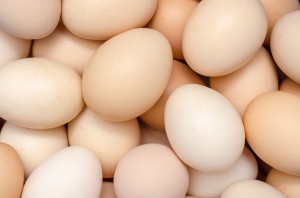Everyone loves eggs. We love them scrambled, fried, poached, hard-boiled, sunny-side up, and over easy. But all that love means producing a whole lot of eggs. There is no question that creating a sustainable food supply for the rapidly increasing population of the planet is going to require us to do things differently when it comes to how we grow and raise our food.
A new study shows that the egg industry has already started implementing new methods and more effective resource usage practices and is out at the head of the pack when it comes to improving overall efficiency of the processes used to produce eggs while simultaneously finding ways to produce more eggs with fewer resources.
What better way to celebrate National Egg Month than to acknowledge how this industry is leading the way into the future of food sustainability and improved animal husbandry.
The study, which was conducted by the Egg Industry Center, looked at 50 years of egg data to understand the effects of the eco-conscious changes to standard chicken raising processes that were made during that time span. The study found that the Egg Industry has been able to boost overall production to meet consumer demand while decreasing the environmental footprint of the industry across the board.
Basically, they have gotten significantly better at producing more eggs with fewer resources.
Here are some of the study’s key findings. You can read the whole study here.
- Egg production released 71% less greenhouse gases in 2010 than it did in 1960
- One dozen eggs today can be raised using 32% less water than was required to produce the same amount of eggs in 1960
- In order to get the same number of eggs, hens in the 1960 would have consumed twice as much feed as their modern day counterparts
- Today’s hens provide 27% more eggs per day than their 1960 peers
- Modern hens live longer lives than those raised 50 years ago.
- While the U.S. population has grown by 72% in the 50 year time span, the number of hens required to meet the increase in demand only went up by 18%
The study also shows that the decrease in environmental footprint is the result of many different factors working together to create more sustainable practices and processes. This includes better feed, better understanding and control of disease, better housing, and maximizing natural resource usage.
Here in Arizona, Hickman’s Family Farms is the largest egg producer with around 5 million laying hens and the ability to process 375,000 eggs per hour at their facility. Hickman’s is committed to sustainable practices and has leveraged everything from the when their buildings are built to robotic helpers to maximize their resource use. You can learn more about how your eggs go from the farm to the table in this video that shows an egg’s journey.
Related articles
- Chew on This Tour with Hickman Farms (fillyourplate.org)
- 3 Egg-cellent Ways to Celebrate Eggs in May (fillyourplate.org)
- Little Known Facts About Eggs (fillyourplate.org)



